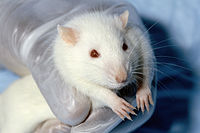
Photo from wikipedia
Abstract The great gerbil (Rhombomys opimus) is a social rodent living in permanent, complex burrow systems distributed throughout Central Asia, where it serves as the main host of several important… Click to show full abstract
Abstract The great gerbil (Rhombomys opimus) is a social rodent living in permanent, complex burrow systems distributed throughout Central Asia, where it serves as the main host of several important vector-borne infectious pathogens including the well-known plague bacterium (Yersinia pestis). Here, we present a continuous annotated genome assembly of the great gerbil, covering over 96% of the estimated 2.47-Gb genome. Taking advantage of the recent genome assemblies of the sand rat (Psammomys obesus) and the Mongolian gerbil (Meriones unguiculatus), comparative immunogenomic analyses reveal shared gene losses within TLR gene families (i.e., TLR8, TLR10, and the entire TLR11-subfamily) for Gerbillinae, accompanied with signs of diversifying selection of TLR7 and TLR9. Most notably, we find a great gerbil-specific duplication of the MHCII DRB locus. In silico analyses suggest that the duplicated gene provides high peptide binding affinity for Yersiniae epitopes as well as Leishmania and Leptospira epitopes, putatively leading to increased capability to withstand infections by these pathogens. Our study demonstrates the power of whole-genome sequencing combined with comparative genomic analyses to gain deeper insight into the immunogenomic landscape of the great gerbil and its close relatives.
Journal Title: Genome Biology and Evolution
Year Published: 2020
Link to full text (if available)
Share on Social Media: Sign Up to like & get
recommendations!